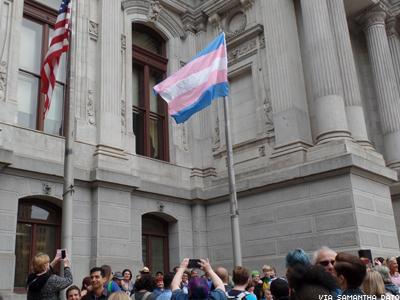Editor’s Note: Last week the transgender Pride flag flew over Philadelphia City Hall – a first, which we hope will become an annual event. Following on that, Dr. Rachel Levine, a transgender woman, was confirmed by the Pennsylvania Legislature as the State’s Physican General. Meanwhile, Caitlyn Jenner graced the cover Vanity Fair. While we’re pleased with all these very positive developments, let’s not forget the significant health disparities confronting transgender people, as discussed in this guest blogpost by our University of Pennsylvania undergraduate student intern, Miriam Chappelka.
 A recent ActionAIDS blog post discussed health disparities associated with bisexuality. I’d like to continue the discussion by considering health care disparities among transgender people. Trans people have disproportionately poor rates of many health indicators such as suicide, mental health, and life expectancy. These health disparities are also visible in their HIV/AIDS risk.
A recent ActionAIDS blog post discussed health disparities associated with bisexuality. I’d like to continue the discussion by considering health care disparities among transgender people. Trans people have disproportionately poor rates of many health indicators such as suicide, mental health, and life expectancy. These health disparities are also visible in their HIV/AIDS risk.
First, some vocabulary: someone who is transgender does not identify with the gender they were assigned at birth. Thus, a trans woman is someone who was assigned male at birth and identifies as a woman; a trans man is someone who was assigned female and birth and identifies as a man. Additionally, gender identity, sexual orientation, and gender expression are different things. For example, a trans women may identify as straight or bisexual or any other sexual orientation. You cannot assume someone’s sexual orientation on the basis of their gender identity or the clothes that they wear.
HIV and Transgender Women
The fastest growing population of HIV positive people in the United States is transgender women. According to the CDC’s page HIV/AIDS Among Transgender People, “the highest percentage of newly identified HIV-positive test results [is] among transgender people.”
 The vast majority of trans people with HIV/AIDS are women. In fact, in New York City, 99 percent of HIV-positive trans people were trans women. Despite the population’s high rates of HIV/AIDS, there has been little research, and data is significantly lacking, making it difficult to ascertain just how many trans women are HIV positive. The CDC notes that existing studies indicate rates between 12 and 28 percent. Of those infected women, many don’t know their status. In a recent study, almost three-fourths of HIV-positive trans women were unaware of their positive status. Especially at risk of being positive are trans women of color; at a staggering 56 percent, black trans women have the highest rates of HIV-positive test results by race and ethnicity.
The vast majority of trans people with HIV/AIDS are women. In fact, in New York City, 99 percent of HIV-positive trans people were trans women. Despite the population’s high rates of HIV/AIDS, there has been little research, and data is significantly lacking, making it difficult to ascertain just how many trans women are HIV positive. The CDC notes that existing studies indicate rates between 12 and 28 percent. Of those infected women, many don’t know their status. In a recent study, almost three-fourths of HIV-positive trans women were unaware of their positive status. Especially at risk of being positive are trans women of color; at a staggering 56 percent, black trans women have the highest rates of HIV-positive test results by race and ethnicity.
Access to Healthcare
One factor that contributes to this extremely high risk of HIV is the fact that many trans people lack access to health care. Those that have access may be reluctant to use it as a result of past negative experiences. In the National Transgender Discrimination Survey Report on Health and Health Care, one in five transgender people reported having been denied access to health care because of their identity; this number was even higher for transgender people of color. The survey revealed that medical settings can be hostile environments for trans people: 28 percent had experienced harassment in medical settings and 2 percent even experienced violence in doctor’s offices. In addition, trans people found that doctors were not aware of issues relating to transgender health. Half of those surveyed reported having to educate their providers about transgender care. As a result of negative experiences with the medical establishment, trans people are much more likely to avoid or delay seeking care.
An unwelcoming environment discourages healthcare seeking behavior. In order to make transgender people more comfortable seeking care, it is crucial to create a gender affirming environment.
Steps health care providers can take to create a more welcoming environment:
- understand that gender identity is not the same as sexual orientation, and patients can have any combination of gender identities and sexual orientations
- don’t assume gender! Ask people how they would like to be referred to. Keep in mind that the gender and name on someone’s official documents may not be the gender they identify as or the name they use
- If you misgender someone, acknowledge it, apologize, and continue the original conversation
- have gender neutral restrooms available
- give appropriate/necessary care
- educate yourself about transgender care
HIV/AIDS among transgender people is a dire issue that has yet to receive the attention that such an epidemic deserves. Trans people are one of the highest risk populations for HIV/AIDS; yet there is very little data or research on their experiences. The little existing data reveals alarming disparity. Our ActionAIDS commitment to helping clients with barriers to care is an important resource in addressing these health disparities.
–Miriam Chappelka, ActionAIDS Development Intern, with special thanks to Roderick Cook from Penn Non-Cis for proofreading for accurate terminology
Health Resources for Trans Individuals in Philadelphia
Philadelphia Trans Health Conference
Where to learn more
Center of Excellence for Transgender Health
Report on Transgender Issues in HIV
National Transgender Discrimination Survey Report on Health and Health Care
The CDC’s factsheet on HIV Among Transgender People

